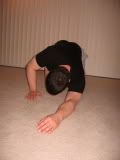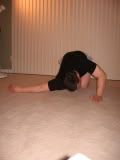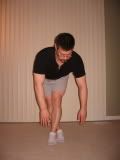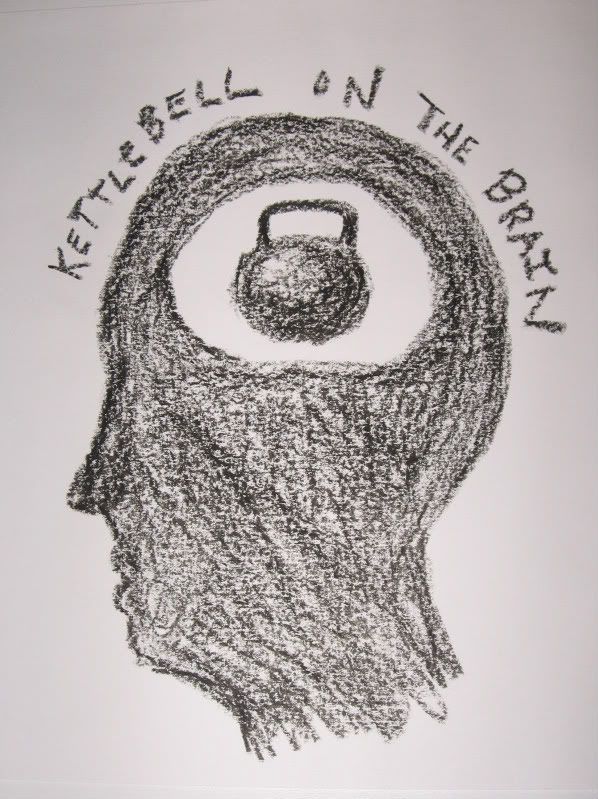No shirt, no drugs...just raw power.
Thursday, April 30, 2009
Wednesday, April 29, 2009
Drinking Kool-Aid (Part I)
"Kool-Aid" comes in many forms in the fitness world of late. CrossFit, Westside (and its many variants), Heavy Duty Training (aka "High Intensity Training"), and 5x5 programs are pretty common in strength and conditioning circles. In the kettlebell world, there are different flavors of Kool-Aid as well.

A couple of questions for the Kool-Aid drinkers out there:
Is it necessary to “drink the Kool-Aid” if you want to see how far a specific program can take you?
If you “drink the Kool-Aid” does that render you completely incapable of seeing a program’s possible limitations?
....to be continued.

A couple of questions for the Kool-Aid drinkers out there:
Is it necessary to “drink the Kool-Aid” if you want to see how far a specific program can take you?
If you “drink the Kool-Aid” does that render you completely incapable of seeing a program’s possible limitations?
....to be continued.
Sunday, April 19, 2009
Daily Stretches For Health & Strength
I've always done a lot of stretching. I started at a young age with my father when he went to the gym and later when I took gymnastics lessons, and in Tae Kwon Do and competitive swimming. I am well aware that the current trend is PNF and "dynamic" stretching - those are great but, despite what some marketeers will tell you, slow static, relaxed stretching is NOT dead. Watch just about any individual gymnast or martial artist warm up and you will see PNF, ballistic, AND traditional stretching methods in the span of 10 or even 5 minutes - you'd be hard pressed to find more powerful athletes and somehow a steady dose of slow stretching hasn't destroyed their strength.
As with anything, stretching should be introduced progressively. "Intensity" and "volume" are difficult to gauge so it's best to be conservative until your body has had time to acclimate to increased range of motion. Although the following stretches can be done at varying speeds and amplitudes, I would suggest starting slow and static, gradually increasing frequency and duration before experimenting with ballistic and dynamic variations.
Pavel says that, stretching, you are trying to "find space" and it's a great way to phrase it. As you stretch, you are finding space within a, heretofore, restricted range of motion.
The following stretches are my "go to" stretches - they have been my "go to" stretches for years. Although I don't do all of them every day, I find time to do most whenever I am in front of a television, or waiting for my wife to finish shopping, or have a spare moment. Stretching does not have to be a full-blown 30 minute yoga session - it can be as short as an elevator ride or a longer than expected phone call.
*Dislocates*
Dislocates, or partial dislocates, can be done with a broomstick, dowel, rope, or towel. Taking too narrow a grip too quickly is asking for elbow strain.




*Lying Shoulder Girdle Stretches*
Two-armed and one-armed variations stress different angles and ranges of motion. Changing the hand position will shift stress of the shoulder girdle to target the scapulae and anterior shoulder girdle.







*Doorway Shoulder Stretch*
This stretch doesn't have to be done in a doorway - it can be done against a wall, in a power rack, or a goal post. The whole forearm should be solidly braced and the body turned to lightly stretch the shoulder and pectoral region.


*Lat/Tricep Stretch*
Elevating the scapula while performing the stretch will shift stress from the tricep to the lat, infraspinatus, and teres minor.

*Good Morning Stretch*
Avoid excessive lower back flexion. Slightly bending the knees (as in a good morning or romanian deadlift) will shift stress from the hamstring insertion at the knee to the hamstring muscle bellies and origins at the hip.

*Seated Hamstring Stretches*
As with the good morning stretch, care should be taken not to excessively flex the lumbar.


*IT Band & Glute Stretches*
I see people struggle with this one all the time - most of the time it becomes just another hamstring stretch rather than hitting the IT band as intended. The key with this stretch is to kick the hip out slightly in the direction of the rear positioned leg. Notice in the pics below my hips move to the left as the upper body moves to the right.



Gently leaning side to side while on all fours will hit the glutes. I don't remember how I "discovered" this one, but it is one of the simplest, yet most effective stretches I have found for the area.



*Quad & Hip Flexor Stretches*
This is another stretch I see performed incorrectly all the time. Done incorrectly, it places stress squarely on the knee joint. Initiated from the hip, it will stretch the hip flexor and quad muscles.


As with anything, stretching should be introduced progressively. "Intensity" and "volume" are difficult to gauge so it's best to be conservative until your body has had time to acclimate to increased range of motion. Although the following stretches can be done at varying speeds and amplitudes, I would suggest starting slow and static, gradually increasing frequency and duration before experimenting with ballistic and dynamic variations.
Pavel says that, stretching, you are trying to "find space" and it's a great way to phrase it. As you stretch, you are finding space within a, heretofore, restricted range of motion.
The following stretches are my "go to" stretches - they have been my "go to" stretches for years. Although I don't do all of them every day, I find time to do most whenever I am in front of a television, or waiting for my wife to finish shopping, or have a spare moment. Stretching does not have to be a full-blown 30 minute yoga session - it can be as short as an elevator ride or a longer than expected phone call.
Dislocates, or partial dislocates, can be done with a broomstick, dowel, rope, or towel. Taking too narrow a grip too quickly is asking for elbow strain.




Two-armed and one-armed variations stress different angles and ranges of motion. Changing the hand position will shift stress of the shoulder girdle to target the scapulae and anterior shoulder girdle.







This stretch doesn't have to be done in a doorway - it can be done against a wall, in a power rack, or a goal post. The whole forearm should be solidly braced and the body turned to lightly stretch the shoulder and pectoral region.


Elevating the scapula while performing the stretch will shift stress from the tricep to the lat, infraspinatus, and teres minor.

Avoid excessive lower back flexion. Slightly bending the knees (as in a good morning or romanian deadlift) will shift stress from the hamstring insertion at the knee to the hamstring muscle bellies and origins at the hip.

As with the good morning stretch, care should be taken not to excessively flex the lumbar.


I see people struggle with this one all the time - most of the time it becomes just another hamstring stretch rather than hitting the IT band as intended. The key with this stretch is to kick the hip out slightly in the direction of the rear positioned leg. Notice in the pics below my hips move to the left as the upper body moves to the right.



Gently leaning side to side while on all fours will hit the glutes. I don't remember how I "discovered" this one, but it is one of the simplest, yet most effective stretches I have found for the area.



This is another stretch I see performed incorrectly all the time. Done incorrectly, it places stress squarely on the knee joint. Initiated from the hip, it will stretch the hip flexor and quad muscles.


Thursday, April 16, 2009
SSST Revisited
Last night I gave the "SSST" (Secret Service Snatch Test) another shot. It is 10:00 of as many 53lb kettlebell snatches as you can do. It's my third time doing it (well, technically, I guess it's my fourth since I attempted it Sunday but stopped a minute early because I can't tell time). I was hoping for 200 reps and I was a little short. But, with as little fast paced snatch work as I've been doing lately, I was very pleased.
Compare this with my first attempt about two years ago (133 reps):
Compare this with my first attempt about two years ago (133 reps):
Monday, April 13, 2009
Friday, April 10, 2009
Bench Press Shirt Explanation
One of the first YouTube videos I ever made about 3 years ago was a video explaining the how a powerlifter's "bench press shirt" works. I realize many people think it's cheating and it certainly isn't for everyone, but bench press shirts, shirts that assist the lifter and add poundages to his/her lift, are a reality that doesn't seem destined to change anytime soon.
I had intended to make a series of videos about bench press shirts, but never got around to it... Take a look and let me know what you think.
I had intended to make a series of videos about bench press shirts, but never got around to it... Take a look and let me know what you think.
Monday, April 6, 2009
Pace Ladder Variations
The pace ladders I introduced previously are easy to implement into training. However, small adjustments to the intervals or numbers can make a huge difference in how fatigue is spread throughout the timed effort. Pace ladders (or waves) can be structured a number of ways to different effect.
Compare the following pace ladders that might be done with the kettlebell snatch (note that dashes indicate a change in pace, and a slash indicates switching hands):
Although the overall pace in the ladders above is slightly different (15rpm vs. 16rpm), the average total pace is not the only difference. In the first ladder, the pace per minute is steady at 15 reps per minute. In the second ladder, the pace varies; 14 reps in the first minute, 16 reps in the second minute, and 18 reps in the third.
A third option for structuring the ladders is to gradually increase the number of rungs within the set.
A fourth option is to gradually increase the number of rungs until you cannot keep up with the time alloted, at which point you would either switch hands and/or start again at the bottom rung. (*=missed interval)
Variations in pace do not need to be "laddered". They can just as easily be waved with the crest and/or the trough remaining constant. For example, consider the following pace waves:
Compare the following pace ladders that might be done with the kettlebell snatch (note that dashes indicate a change in pace, and a slash indicates switching hands):
Pace Ladder A (Even Number of Rungs)
:15 rungs
1-3-5-7-1-3-5-7-1-3-5-7/1-3-5-7-1-3-5-7-1-3-5-7 (90 reps in 6:00)
Pace Ladder B (Odd Number of Rungs)
:15 rungs
2-4-6-2-4-6-2-4-6-2-4-6/2-4-6-2-4-6-2-4-6-2-4-6 (96 reps in 6:00)
Although the overall pace in the ladders above is slightly different (15rpm vs. 16rpm), the average total pace is not the only difference. In the first ladder, the pace per minute is steady at 15 reps per minute. In the second ladder, the pace varies; 14 reps in the first minute, 16 reps in the second minute, and 18 reps in the third.
A third option for structuring the ladders is to gradually increase the number of rungs within the set.
Pace Ladder C (Escalating Ladders)
:15 rungs
2-2-3-2-3-4-2-3-4-5-2-3-4-5-6/2-2-3-2-3-4-2-3-4-5-2-3-4-5-6 (100 reps in 7:30)
A fourth option is to gradually increase the number of rungs until you cannot keep up with the time alloted, at which point you would either switch hands and/or start again at the bottom rung. (*=missed interval)
Ladder D (King of the Mountain)
:20 rungs
1-2-3-4-5-6-7-7*/1-2-3-4-5-6-7-6* (69 reps in 5:20)
Variations in pace do not need to be "laddered". They can just as easily be waved with the crest and/or the trough remaining constant. For example, consider the following pace waves:
Ladder E (Pace Wave, evenly paced among minutes)
:30 rungs
5-10-5-10-5-10/5-10-5-10-5-10 (90 reps in 6:00)
Ladder F (Pace Wave, pace varies among minutes)
:20 rungs
6-4-6-4-6-4-6-4-6/6-4-6-4-6-4-6 (92 reps in 6:00)
Ladder G (Pace Wave, escalating crest)
:20 rungs
3-4-3-5-3-6-3-7/3-4-3-5-3-6-3-7 (68 reps in 5:20)
Sunday, April 5, 2009
Thursday, April 2, 2009
Subscribe to:
Comments (Atom)







